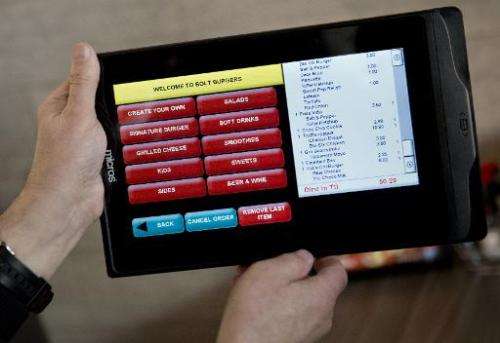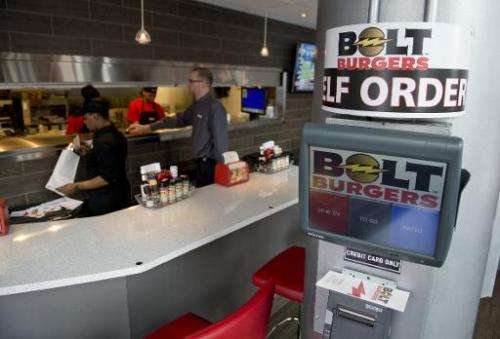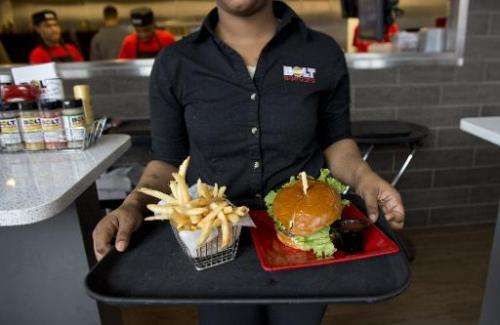Mike Davidson, co-owner of Bolt Burgers, demonstrates a portable tablet computer for customers to order food and drinks at Bolt Burgers in Washington, DC, February 25, 2014
At the Bolt Burgers restaurant in downtown Washington, diners can order a meal through a live person, but many prefer to use the touchscreen tablets.
"I absolutely loved it, and was thinking I wished we had this kind of thing back in Wisconsin," said John Morrissey of Kenosha, Wisconsin, where he is police chief.
Many customers at the fast casual eatery use a tablet installed at a kiosk or one of the electronic menu tablets handed to diners when they enter.
"The number of people who prefer to use technology is much greater than we expected," says co-owner Mike Davidson.
Joe Spinelli, another co-owner, said younger customers who are at ease with technology are big tablet users.
"People like the speed, and in our business, speed is everything," he said.
Bolt Burgers is among the early adopters of tablets and technology to view, order and pay for meals.
Some of the largest US restaurant chains have announced they are installing tablets to boost efficiency and respond to customer interests.
Some 800 restaurants in the Chili's restaurant chain have been installing the tablet supplied by Ziosk, a Texas-based firm which makes the tabletop devices for ordering and paying as well as for news and entertainment while dining.
"Guests love the Ziosk," company marketing chief John regal told AFP.
"They can control the pace or their meal. They can order either with the server or the device."
A kiosk for customers to order food and drinks at Bolt Burgers in Washington, DC, February 25, 2014
Getting out the door
Customers who want to leave quickly without waiting for their server to bring a check can pay with a tablet.
"We can get you out the door right away instead of having to wait 10 minutes or more," Regal says.
Regal says the tablets are being used to complement waiters, not to replace them. Initial orders go through the server and the tablets are used for reorders, desserts and to pay.
"It's technically possible" to order everything on the tablet, but customers still want to interact with people at a restaurant, Regal said.
"The Ziosk is really a second or third person on the service team," he said.
Having a tablet on the table "is a way for restaurants to differentiate themselves, and it gives the servers a little extra time to interact with the customers."
Ziosk installs the tablets without any initial cost to the restaurants, and charges a monthly fee. But restaurants can recover that and in some cases boost income because they get a share of revenues from tablet ads and fee-based games, the company says.
A Ziosk rival is the Intel-backed group E la Carte, which recently announced a deal to install its Presto tablets in 1,800 Applebee's restaurants by the end of 2014.
The Presto tablets similarly allows diners to pay at their table, add drinks or desserts and play games. The company is working on new functions such as video streaming, social media interaction.
"Let's face it, everyone who has ever been to a restaurant has been frustrated by waiting for their check," said Applebee's president Mike Archer in a statement.
"Starting out, our goal was to create a way for guests to control when and how they pay their check. What we learned after nearly two years of testing is we can provide much more. The Presto tablet will deliver our guests a robust slate of offerings for not only transactions, but entertainment, social interaction and more, moving forward."
A server carries a tray with a hamburger and french fries at Bolt Burgers in Washington, DC, February 25, 2014
More tips
At the Consumer Electronics Show, Intel chief Brian Krzanich said that tablets were helping restaurants and consumers.
"What's really interesting is they've found that waiters have received 15 percent higher tips—better dining experience, better tips for the waiter," Krzanich said.
A National Restaurant Association study found use of tablets and kiosks is growing.
Just seven percent in an October survey said they had used a restaurant touchscreen terminal. But more than 40 percent said they would use one if offered. The number increases among people with children.
"The restaurant industry is labor-intensive so it makes sense that operators are using technology to boost efficiency and productivity," says Hudson Riehle, a senior vice president for research at the restaurant association.
Riehle says the technology is positive for consumers as well: "Using the tablet can allow people to find not only the sourcing of a product but also how it is prepared, the nutritional value and a host of other information that previously wasn't available."
The tablet on a table "allows people a chance to read a newspaper online or play a game to occupy their kids," says Mary Chapman at the research firm Technomic.
"But the downside is that restaurants lose the ability of the server to control the experience."
© 2014 AFP

























